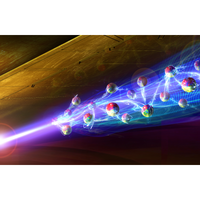Abstract
Light-matter interaction is well understood on the single-atom level and routinely used to manipulate atomic gases. However, in denser ensembles, collective effects emerge that are caused by light-induced dipole-dipole interactions and multiple photon scattering. Here, we report on the observation of a mechanical deformation of a cloud of ultracold atoms due to the collective interplay of the atoms and a homogenous light field. This collective light scattering results in a self-confining potential with interesting features: It exhibits nonlocal properties, is attractive for both red- and blue-detuned light fields, and induces a remarkably strong force that depends on the gradient of the atomic density. Our experimental observations are discussed in the framework of a theoretical model based on a local-field approach for the light scattered by the atomic cloud. Our study provides a new angle on light propagation in high-density ensembles and expands the range of tools available for tailoring interactions in ultracold atomic gases.
2 More- Received 2 February 2022
- Accepted 21 June 2022
DOI:https://doi.org/10.1103/PhysRevX.12.031018
Published by the American Physical Society under the terms of the Creative Commons Attribution 4.0 International license. Further distribution of this work must maintain attribution to the author(s) and the published article’s title, journal citation, and DOI.
Published by the American Physical Society
Physics Subject Headings (PhySH)
Popular Summary
The interaction between individual atoms and laser light is well understood, and scientists routinely use light to trap and control small particles. But adding more atoms leads to complex phenomena mediated by multiple scatterings where the particles collectively interact with a light beam. One of these collective effects is that the incoming laser triggers an effective force between the atoms. This work presents the first observation of this force.
Our experiment starts by packing ultracold rubidium atoms into a dense, needle-shaped cloud. When a laser hits this cloud, each atom becomes an oscillating dipole emitting its own radiation. The next atom sees not only the laser field but also the light scattered by the first dipole—and of all other dipoles in the cloud. Through these interactions, the laser induces an effective dipole-dipole interaction.
This collective interaction can be interpreted as an effective optical force that arises because of the modification of the incoming light beam by the atomic cloud itself: For some laser frequencies, the cloud acts like a weak lens, focusing the light inside the atomic ensemble, roughly at regions of maximal particle density. Incidentally, the atoms are also pulled toward regions of high light intensity. This creates a feedback loop where atoms focus the light inside the cloud and the light pulls the atoms toward its focus. Experimentally, we observe that the light beam triggers a radial compression of the quasi-1D cloud.
Studying this compression provides a new way to test theoretical models on light propagation in high-density ensembles. Light-induced dipole-dipole interactions might also become a new tool to trap, control, and manipulate ultracold atomic gases.



